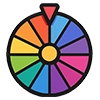Spin The Wheel Online - Free Random Wheel Generator
 Powered by SpinzyWheel.com
Powered by SpinzyWheel.com Powered by SpinzyWheel.com
Powered by SpinzyWheel.com[h2] 💻 Introduction to Coding Word You Know SpinzyWheel [/h2]
Coding words — short terms like loop, variable, or function — are the building blocks of programming language. For beginners, these words may sound like a special code or secret words, but once you understand them, they open up a world of logic, creativity, and problem solving. The Coding Word You Know SpinzyWheel makes learning programming vocabulary fun and interactive. Instead of memorizing lists, learners spin the wheel, share a coding word they know, explain it briefly, and help classmates connect words with real examples.
This activity works great in classrooms, coding clubs, or family learning time. It helps demystify technical language while encouraging speaking, listening, and peer teaching. Each turn gives someone a chance to be the tiny teacher for a moment — a simple but powerful way to build confidence. The wheel also celebrates small wins: knowing one coding word is progress!
[h2] 🌟 Why Learning Coding Words Matters [/h2]
[h3] 🧠 Builds Understanding[/h3]
Programming is like a language; vocabulary gives you the tools to read and write code. Knowing words helps learners understand instructions, tutorials, and problems.
[h3] 🔎 Clarifies Concepts[/h3]
A clear definition — and a short example — turns abstract ideas into practical steps. For example, a “variable” becomes easier to grasp when tied to a concrete example: a box that stores a number.
[h3] 🤝 Encourages Collaboration[/h3]
When students share terms and examples, they learn from each other. Different explanations help reach different learners.
[h3] 🎯 Boosts Problem Solving[/h3]
Vocabulary supports logical thinking. Understanding terms like “condition” or “loop” helps students plan how to solve a problem before writing code.
[h2] 🎡 How the SpinzyWheel Works [/h2]
[h3] 📝 Step 1: Prepare a Word Wheel[/h3]
Create a wheel (paper, cardboard, or digital) with slices for different coding categories: basic terms, data, control flow, functions, debugging, and tools.
[h3] 🎲 Step 2: Spin and Share[/h3]
A student spins the wheel. When it stops, they say one coding word they know (from the slice or their choice), give a one-sentence explanation, and, if possible, a tiny example.
[h3] 💬 Step 3: Quick Demonstration[/h3]
If time allows, the student shows a short demo — draw a tiny diagram, write one line of pseudocode, or give a real-world analogy.
[h3] 🏆 Step 4: Celebrate and Add[/h3]
Give a sticker, a point, or applause. Add the shared word to a classroom word wall or shared list so everyone can revisit it later.
[h2] 💡 Benefits of the Coding Word Wheel [/h2]
[h3] 🎉 Makes Vocabulary Fun[/h3]
Turning words into a game changes studying into play. The wheel’s randomness keeps learners curious.
[h3] 🧩 Reinforces Memory[/h3]
Hearing, speaking, and briefly demonstrating a word strengthens recall more than just reading it.
[h3] 🗣️ Improves Communication Skills[/h3]
Explaining technical terms in simple language helps learners communicate clearly — an important developer skill.
[h3] 🔄 Encourages Variety[/h3]
The wheel ensures learners encounter a mix of words (logic, data, UI, tools), so their knowledge grows evenly.
[h2] ✨ Tips for Teachers and Group Leaders [/h2]
[h3] 👥 Pair Sharing[/h3]
After one person shares, pair them with a classmate to teach the word again — teaching boosts understanding.
[h3] 📚 Word Wall[/h3]
Keep a visible list of shared words and short definitions. Students can add examples later.
[h3] 🧪 Mini Challenges[/h3]
Turn a shared word into a tiny challenge: “Use the word loop to plan 3 steps for repeating a task.”
[h3] 🔁 Repeat Often[/h3]
Use quick wheel rounds as daily warmups. Small, repeated practice builds strong foundations.